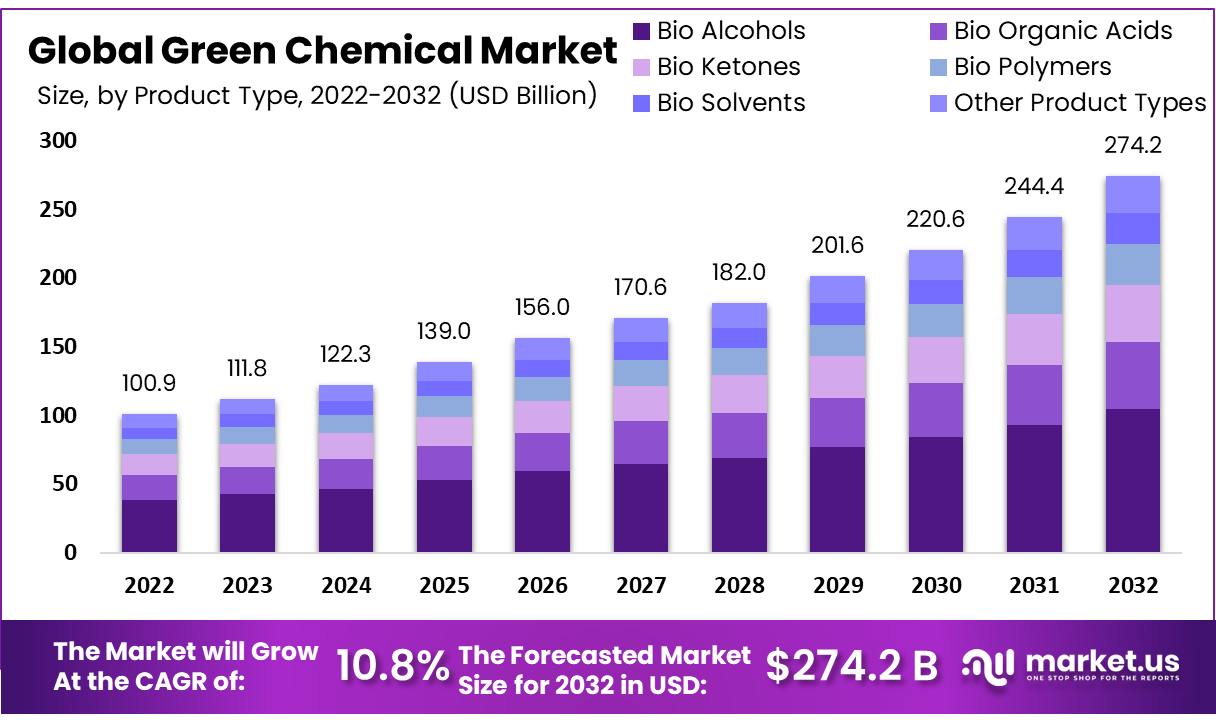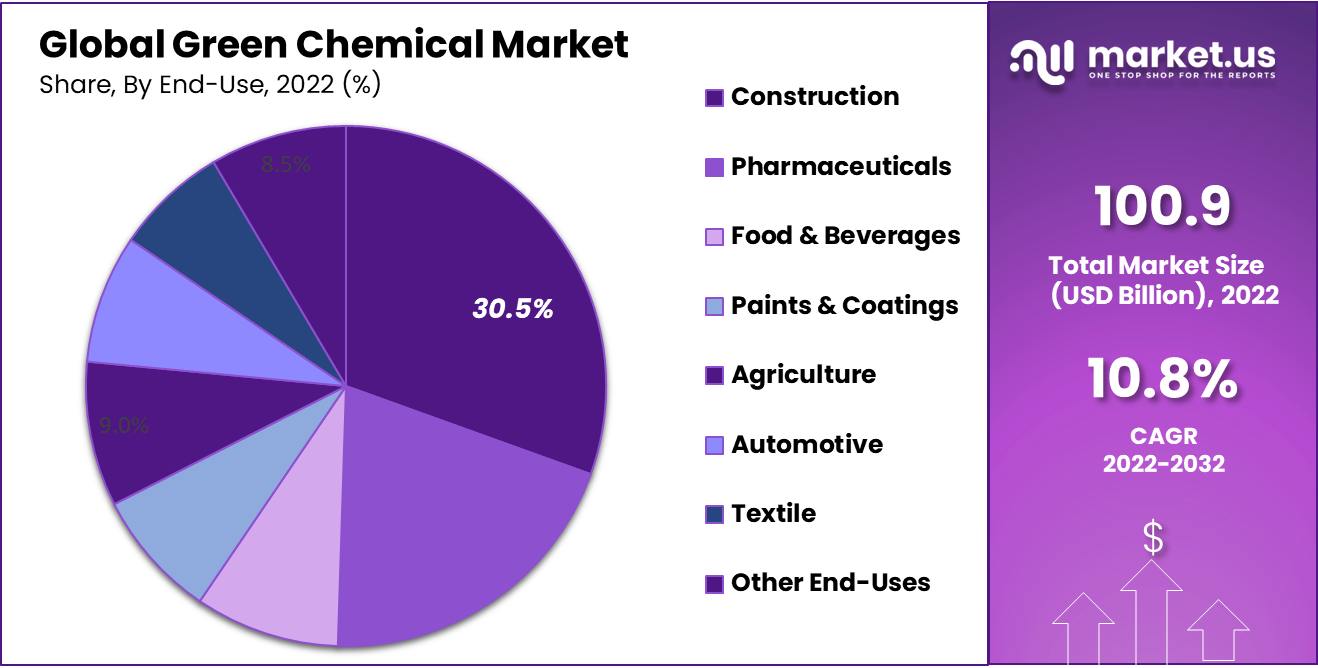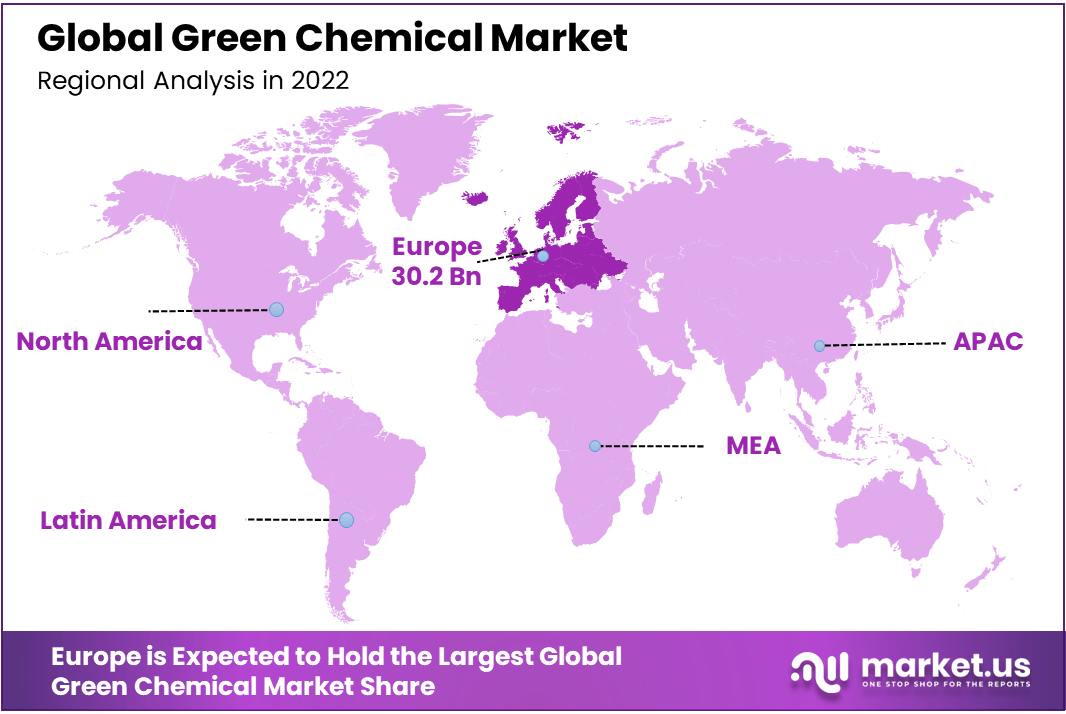Global Green Chemicals Market By Product Type (Bio Alcohols, Bio Organic Acids, Bio Ketones, Bio Polymers, Bio Solvents) By Source (Plant-Based, Algae-Based, Bio-Waste) By End-Use (Construction, Pharmaceuticals, Food & Beverages, Paints & Coatings, Agriculture, Automotive, Textile), By Region and Companies - Industry Segment Outlook, Market Assessment, Competition Scenario, Trends, and Forecast 2023-2032
- Published date: Oct 2023
- Report ID: 14690
- Number of Pages: 388
- Format:
- keyboard_arrow_up
Quick Navigation
Report Overview
In 2022, the Green Chemicals Market was valued at USD 100.9 billion and is expected to reach USD 274.2 Billion in 2032, Between 2022 and 2032, this market is estimated to register a CAGR of 10.8%.
Green or bio-based chemicals have minimal environmental and human health impacts. These chemicals are produced from bio-based materials such as algae, plants, and bio waste. Green chemicals are aimed to be less toxic throughout their life cycle.
These chemicals have wide-ranging applications across numerous sectors, including agriculture, paints & coatings, construction, automotive, textiles, pharmaceuticals, water treatment, and food and beverage sectors.
By opting for green chemicals, these industries contribute to a more sustainable approach to manufacturing and reduce their ecological footprint. The adoption of green chemicals in different industries is an ongoing process driven by evolving technology and increased awareness of environmental issues.
Regulatory bodies worldwide have set guidelines, certifications, and eco-labels to guide industries and consumers toward more environment-friendly choices. As the global demand for sustainable solutions intensifies, the application of green chemistry principles is set to expand, leading to a more sustainable and eco-responsible approach to production and consumption.
 Actual Numbers Might Vary in the Final Report
Actual Numbers Might Vary in the Final ReportKey Takeaways
- Market Size: The global green chemicals market is expected to witness a compound annual growth rate (CAGR) of 10.8% from 2023 to 2032.
- Market Trend: Green chemicals, driven by the focus on sustainability and environmental concerns, have been gaining remarkable popularity across various industries.
- Product Type Analysis: Of these, the bioalcohol segment emerged as the most profitable in the global green chemical market, commanding a market share of 38% in 2022. Its projected CAGR is estimated to reach 11.2%.
- By Source Analysis: The market is categorized by source into plant-based, algae-based, bio-waste, and other sources. Among these, plant-based green chemicals dominated, holding the largest market share.
- End User Analysis: Of these, the construction segment held a 30.5% share of the total market for green chemicals in 2022. It is expected to maintain a CAGR of 11.6% during the forecasted period.
- Drivers: The increasing emphasis on sustainability, stringent environmental regulations, and the shift towards renewable and bio-based sources.
- Restraints: Technological challenges, higher upfront costs, and the need for wider market acceptance and adoption.
- Opportunities: Growing consumer awareness, advancements in green chemical technologies, and supportive government policies.
- Challenges: Achieving cost competitiveness, scaling up production, and overcoming traditional industry mindsets.
- Regional Analysis: Europe occupied the top position in the global market, boasting a considerable market share.
- Key Players Analysis: Major players in the green chemicals market include Arkema Group, Balfour Beatty Plc, BASF SE, Bio Kleen, Cargill Inc., Du Pont De Nemours Inc., Evonik Industries AG, George Weston Foods Ltd., GFBiochemicals Ltd., Givaudan, Green chemicals S.r.l., JSW Cement Ltd., Koninklijke DSM NV, Mitsubishi Chemical Holdings Corp., NatureWorks LLC, Novamont Spa, Other Key Players.
Driving Factors
Environmental Awareness & Regulatory Policies and Increasing Demand from Various Industries Propel Global Green Chemical Market
Individuals are becoming more aware that synthetic chemicals can harm the environment. As a response, several governments around the world are making rules stricter for the production of chemicals. This encourages companies to use more eco-friendly methods.
For instance, the REACH law by the European Union puts limitations on dangerous substances, making manufacturers consider the use of green chemistry more seriously.
Major industries that use chemicals, such as those producing medicines, plastic products, and beauty products, are showing more preference for green chemicals. These are less harmful and better for the environment. Consumers are asking for safer and more sustainable products, leading these industries to use green chemicals instead of regular ones.
This change is visible in the beauty industry, where ‘clean beauty’ is becoming a big trend. This means making products that do not contain harmful substances and using green chemistry instead.
Restraining Factors
High Production Costs and Lack of Hinder the Market Growth
Green chemical manufacturing requires complex techniques and advanced technologies, leading to higher costs than traditional chemical products. Expenses such as catalysts for biomass conversion, energy inputs, and infrastructure setup, particularly in developing regions, elevate costs. Consequently, green chemical prices are high, which could deter potential consumers, thereby hindering market growth.
A lack of awareness about the benefits of green chemicals stifles the demand for green chemicals. Moreover, the regulatory support for green chemicals is not consistent worldwide. While some regions, like the European Union, have strong regulations encouraging the use of green chemicals, many other regions lack such regulations. Without governmental incentives, companies may find green alternatives economically unfeasible.
Market Scope
By Product Type Analysis
The Bio Alcohols Segment Held The Largest Market Share in 2022
Based on product type, the market for green chemicals is segmented into bio alcohols, bioorganic acids, bio ketones, biopolymers, bio solvents, and other product types. Among these, the bioalcohol segment was the most lucrative in the global green chemical market, with a market share of 38% in 2022, and it is estimated to project a CAGR of 11.2%.
This can be attributed to their extensive application in transportation, pharmaceuticals, and food & beverages industries. Bio-alcohols market, such as bioethanol and biobutanol, serve as viable renewable alternatives to traditional fossil fuels, which has driven their adoption in the transport sector.
The bio-polymers segment is the fastest-growing segment. Due to the increasing use in packaging, agriculture, automotive, and medical industries. This can be attributed to their biodegradability and sustainable production processes, which align with the global push towards environmental consciousness and reducing plastic waste.
By Source Analysis
The Plant-Based Source Segment is Dominant in the Global Green Chemical Market
By source, the market is further divided into plant-based, algae-based, bio-waste, and other sources. Among these, plant-based green chemicals held the largest market share. Plant-based green chemicals have gained significant popularity due to their sustainable and renewable nature. They are derived from various plants and crops, making them an attractive choice for environmentally conscious consumers and industries.
Following the plant-based sources, the algae-based source accounted for the largest market share in 2022. Algae are a promising source of green chemicals due to their high growth rate, ease of cultivation, and potential for carbon sequestration. They can be cultivated in various environments, including wastewater treatment plants, making them an attractive option for sustainable chemical production.
By End-Use
The Construction Segment Dominated the Global Market In 2022
Based on end-use, the market is further segmented into construction, pharmaceuticals, food & beverages, paints & coatings, agriculture, automotive, green textile chemicals, and Other End-Uses. Among these, the construction segment accounted for 30.5% of the total market share for green chemicals in 2022, and it is anticipated to register a CAGR of 11.6% in the forecasted period.
The dominance of this segment is attributed to the increasing demand for eco-friendly materials and sustainable construction practices in the construction industry, driven by rising environmental awareness and government regulations promoting green building initiatives.
Pharmaceuticals accounted for the second largest market share in the market in 2022. The pharmaceutical industry has been increasingly adopting green chemicals in drug development and manufacturing processes to reduce environmental impact and improve the sustainability of their operations. This move towards greener practices was fueled by stricter environmental regulations and growing consumer preference for environmentally friendly products in the healthcare sector.

Key Market Segments
Based on Product Type
- Bio Alcohols
- Bio Organic Acids
- Bio Ketones
- Bio Polymers
- Bio Solvents
- Others Product Types
Based on Source
- Plant-Based
- Algae-Based
- Bio-Waste
- Other Sources
Based on End-Use
- Construction
- Pharmaceuticals
- Food & Beverages
- Paints & Coatings
- Agriculture
- Automotive
- Textile
- Other End-Uses
Growth Opportunities
Growing Demand for Smart and Sustainable Glass Products
The global green chemicals market is expected to witness significant growth opportunities in the future due to the increasing awareness of environmental issues has led consumers and businesses to seek eco-friendly products with minimal impact on the planet. Green chemicals, made from renewable sources and with lower carbon footprints, are likely to gain popularity, as sustainability becomes a priority.
Furthermore, governments worldwide are implementing supportive policies and regulations to encourage the use of green chemicals and reduce harmful substances. These measures may offer incentives for businesses to adopt eco-friendly practices, creating a facilitative environment for the growth of green chemical companies.
Continuous advancements in green chemistry research and technology are expected to lead to more efficient and cost-effective methods of producing green chemicals, driving wider adoption and fostering market expansion.
Latest Trends
Rising Consumer Awareness and Government Support for Sustainability
The global green chemicals market is witnessing various trends in recent years that are driving the market. One of the key trends is the rising consumer awareness about the environmental impact of their choices. As consumers become more conscious of sustainability, there is a rising demand for eco-friendly products, boosting the need for green chemicals.
Furthermore, the increasing adoption of bio-based packaging materials due to concerns about plastic waste and environmental pollution contributes to the market’s expansion. As bio-based packaging gains popularity, there is a corresponding increase in the demand for green chemicals used in their production.
Similarly, the escalating need for alternative fuels, such as biodiesel and bioethanol, propels the demand for green chemicals used in their manufacturing processes. Moreover, various governments actively promote sustainability and reduce carbon emissions, creating favorable conditions for green chemical companies. This regulatory support opens up opportunities for further growth and innovation in the industry.
Regional Analysis
Europe is the Dominant Region in the Global Green Chemical Market
In 2022, Europe held the leading position in the global market with a significant market share. The region’s remarkable market share can be largely attributed to the increasing demand for eco-friendly products, the presence of renowned companies, and the growing adoption of green chemicals across various industries such as food and beverage, personal care, automotive, and packaging.
The European chemicals industry is proactively focusing on developing and producing green chemicals to foster sustainable and environmentally friendly solutions.
North America has been a major player in the green chemicals market, accounting for a significant share due to the presence of several key players, government support, and increasing awareness about sustainable practices. Europe, too, held a substantial market share, driven by strict environmental regulations and a strong focus on sustainability.

Key Regions and Countries
- North America
- The US
- Canada
- Europe
- Germany
- France
- The UK
- Spain
- Italy
- Russia & CIS
- Rest of Europe
- APAC
- China
- Japan
- South Korea
- India
- ASIAN
- Rest of APAC
- Latin America
- Brazil
- Mexico
- Rest of Latin America
- Middle East & Africa
- GCC
- South Africa
- Rest of MEA
Key Players Analysis
Key players in the market, including BASF SE, DuPont, Solvay, Dow Chemical Company, BioAmber, Clariant, Novozymes, Genomatica, Croda International, and Evonik Industries, were actively engaged in research and development of eco-friendly alternatives, bio-based chemicals, and sustainable solutions across various sectors.
The competitive landscape was dynamic and evolving, with companies vying for market share and driving innovation to meet the increasing demand for green chemicals.
Market Key Players
- Arkema Group
- Balfour Beatty Plc
- BASF SE
- Bio Kleen
- Cargill Inc.
- Du Pont De Nemours Inc.
- Evonik Industries AG
- George Weston Foods Ltd.
- GFBiochemicals Ltd.
- Givaudan
- Greenchemicals S.r.l.
- JSW Cement Ltd.
- Koninklijke DSM NV
- Mitsubishi Chemical Holdings Corp.
- NatureWorks LLC
- Novamont Spa
- Other Key Players
Recent Developments
- In May 2023, NTPC Green Energy Limited (NGEL) and HPCL Mittal Energy Limited (HMEL) joined hands to explore opportunities in the green hydrogen business & its derivatives (Green Ammonia and green Methanol)
- In June 2022, JSW Cement Limited entered into the construction chemicals sector by introducing a new line of eco-friendly products. These products use less water during application and replace river sand with screen slag in concrete, promoting the conservation of natural resources and helping to prevent environmental issues such as landslides, floods, and air pollution.
Report Scope
Report Features Description Market Value (2022) USD 100.9 Bn Forecast Revenue (2032) USD 274.2 Bn CAGR (2023-2032) 10.8% Base Year for Estimation 2022 Historic Period 2016-2022 Forecast Period 2023-2032 Report Coverage Revenue Forecast, Market Dynamics, COVID-19 Impact, Competitive Landscape, Recent Developments Segments Covered By Product Type (Bio Alcohols, Bio Organic Acids, Bio Ketones, Bio Polymers, Bio Solvents, Others Product Types), By Source (Plant-Based, Algae-Based, Bio-Waste, Other Sources), By End-Use (Construction, Pharmaceuticals, Food & Beverages, Paints & Coatings, Agriculture, Automotive, Textile, Other End-Uses) Regional Analysis North America – The US & Canada; Europe – Germany, France, The UK, Spain, Italy, Russia & CIS, Rest of Europe; APAC- China, Japan, South Korea, India, ASEAN & Rest of APAC; Latin America- Brazil, Mexico & Rest of Latin America; Middle East & Africa- GCC, South Africa, &Rest of MEA Competitive Landscape Arkema Group, Balfour Beatty Plc, BASF SE, Bio Kleen, Cargill Inc., Du Pont De Nemours Inc., Evonik Industries AG, George Weston Foods Ltd., GFBiochemicals Ltd., Givaudan, GREENCHEMICALS Spa, JSW Cement Ltd., Koninklijke DSM NV, Mitsubishi Chemical Holdings Corp., NatureWorks LLC, Novamont Spa, Other Key Players. Customization Scope Customization for segments, region/country-level will be provided. Moreover, additional customization can be done based on the requirements. Purchase Options We have three licenses to opt for: Single User License, Multi-User License (Up to 5 Users), Corporate Use License (Unlimited User and Printable PDF) Frequently Asked Questions (FAQ)
What is the green chemical market?The green chemical market refers to the sector within the chemical industry that focuses on producing and utilizing chemicals in an environmentally friendly and sustainable manner. These chemicals are designed to have minimal impact on human health and the environment throughout their lifecycle – from production to disposal.
What is the market size for Green Chemicals Market?In 2022, the Global Green Chemicals Market was valued at USD 100.9 billion and is expected to reach USD 274.2 Billion in 2032, Between 2023 and 2032.
What CAGR is projected for the Green Chemical Market Market?The Green Chemical Market is expected to grow at 10.8% CAGR (2022-2032)

- Arkema Group
- Balfour Beatty Plc
- BASF SE Company Profile
- Bio Kleen
- Cargill Inc.
- Du Pont De Nemours Inc.
- Evonik Industries AG
- George Weston Foods Ltd.
- GFBiochemicals Ltd.
- Givaudan SA Company Profile
- Greenchemicals S.r.l.
- JSW Cement Ltd.
- Koninklijke DSM NV
- Mitsubishi Chemical Holdings Corp.
- NatureWorks LLC
- Novamont Spa
- Other Key Players
- settingsSettings
Our Clients
| Single User $4,599 $3,499 USD / per unit save 24% | Multi User $5,999 $4,299 USD / per unit save 28% | Corporate User $7,299 $4,999 USD / per unit save 32% | |
|---|---|---|---|
| e-Access | |||
| Report Library Access | |||
| Data Set (Excel) | |||
| Company Profile Library Access | |||
| Interactive Dashboard | |||
| Free Custumization | No | up to 10 hrs work | up to 30 hrs work |
| Accessibility | 1 User | 2-5 User | Unlimited |
| Analyst Support | up to 20 hrs | up to 40 hrs | up to 50 hrs |
| Benefit | Up to 20% off on next purchase | Up to 25% off on next purchase | Up to 30% off on next purchase |
| Buy Now ($ 3,499) | Buy Now ($ 4,299) | Buy Now ($ 4,999) |


 Actual Numbers Might Vary in the Final Report
Actual Numbers Might Vary in the Final Report








